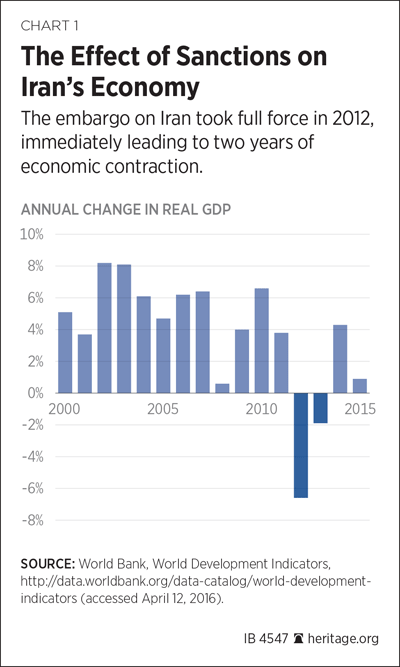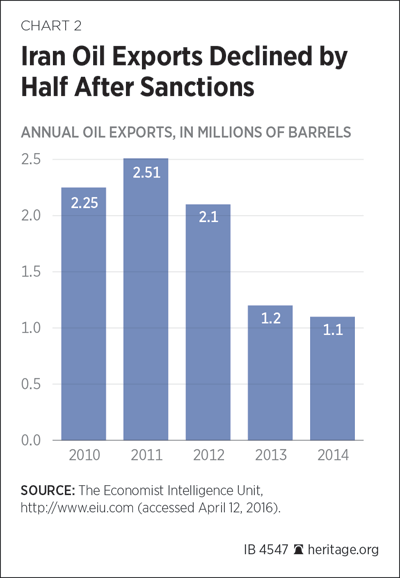In a landmark agreement reached in January 2016, the International Atomic Energy Agency judged that Iran was compliant with its internationally agreed upon nuclear obligations. The nuclear deal that the Obama Administration helped to negotiate remains controversial and contested in the U.S. In fact, U.S. commitments under it could well be overturned by the next President. In the meantime, it is worth noting that the deal will have a major impact on Iran, which is still at odds with the U.S. on a wide range of national security matters.
As part of the accord, the U.S. and the European Union (EU) will terminate all nuclear-related economic sanctions, including an embargo on buying Iranian crude oil and an end to restrictions on Iranian trade, shipping, and insurance. Approximately 300 Iranian individuals and companies will be removed from the EU sanctions list and, most critically, Iran will regain access to the international financial system and currency markets. As a result, Iran will be able to export as much crude oil to the world as it is capable of exporting.
These developments have the potential to restore Iran’s long-lost economic vitality and have an enormous impact on global oil production and prices. Consequently, they also present new challenges for American policy.
The Macro Impact of the Sanctions
Within the economics profession, there is considerable debate about the impact of economic sanctions. The most stringent parts of the Iranian embargo took effect in July 2012. In Iran’s case, the sanctions appear to have been extraordinarily effective in impacting economic activity.
The year before the sanctions, real gross domestic profit (GDP) expanded at a healthy 3.8 percent pace. When the sanctions were enacted in mid-year 2012, the economy contracted 6.6 percent and 1.9 percent in 2012 and 2013, respectively. After a positive bounce back from lows the previous two years, it grew less than 1 percent in 2015. This contraction is much greater than the one experienced during the 2008–2009 global crisis when the fall in energy prices was even larger.
While Iran continued to export oil to some Asian nations, such as South Korea, the inability to export to Europe took a toll. After exporting approximately 2.5 million barrels a day in 2011, Iran saw its exports fall to a little over one million per day by 2014. Petroleum accounts for 80 percent of total exports.
One cannot overstate the importance of energy to the Iranian economy. The world’s fourth largest oil producer, Iran’s total production currently stands at approximately three million barrels per day. Exports of energy accounted for 24 percent of GDP in 2014. In the first half of fiscal year (FY) 2015–2016, Iran derived 37.5 percent of its total government revenue from energy.
Over this same period, the European Union’s bilateral trade with Iran fell from $28 billion in 2011 to $12.8 billion in 2014.
Some Positive Prospects
Despite oil prices being at their lowest level (as of March 2016) since the 2008–2009 global recession, Iran has the prospects of mounting an economic comeback. With the sanctions lifted, Iran could boost its GDP growth by approximately 5 percent in 2016–2017.
Without the sanctions, the many attractive and productive elements of Iran’s economic culture can operate and produce at their full capacity.
Iran boasts a young and well-educated workforce, living in largely urban populations. The motor vehicle industry is the largest in the Middle East and Peugeot Citroen is planning on returning to Iran. Some of the Global 100 companies are once again eyeing Iran.
Iran’s economy is far more diverse than that of Saudi Arabia or any of the other energy producers in the region. According to Iran’s first Vice-President Eshaq Jahangiri, sanctions had added 15 percent to the cost of trading with Iran, and lifting them will save the country some $15 billion a year in lower trade costs.[1]
Lifting the sanctions will make more than $30 billion in assets held overseas immediately available to Iran. Official Iranian reports have set the total amount of frozen assets overseas at $100 billion.
Iran’s readmission to the global banking system and payment network such as SWIFT will drive down the cost of imports since Iranian businesses have not had access to letters of credit and have had to pay up front in full for imports. The International Monetary Fund (IMF) estimates that ending such restrictions could add up to a percentage point to annual growth.
In the post-sanction regime, Iran could witness a major recovery in its oil and gas sector. According to the Economist Intelligence Unit (EIU), Iran has 157 billion barrels of oil in proven reserves (the fourth largest in the world). According to the International Energy Agency, about 38 million barrels of oil are in Iran’s floating reserves and could immediately enter the market.
Iran is hoping to increase total exports to around 2.5 million barrels a day later this year and has stated that oil and condensate exports have already hit 1.75 million barrels per day.[2]
At current prices (approximately $40 per barrel in March 2016), the lifting of energy sanctions means Iran could increase its revenue from oil exports by $10 billion by next year.
Serious Problems Remain
First and foremost, it took years to put the sanctions in place; removing them is a process that will take time. Moreover, according to the EIU, given the complexity of remaining sanctions, both those put in place by the Clinton Administration in 1995 and the significant listing of organizations and individuals because of terrorism or human rights issues, U.S. firms will not return to the Iranian market soon.
In fact, the Iranian economy is in shambles. Unemployment and inflation are in double digits and labor productivity is low. Infrastructure is crumbling and the capital markets need developing. While the mostly closed stock market is now becoming more open to foreign investors, as of March 2016, the 300-member benchmark TEDPIX index was trading at just 5.7 times earnings versus 13 times earnings for the developing economies.
In the 2016 Index of Economic Freedom, co- published by The Heritage Foundation and The Wall Street Journal, Iran is rated 171st out of 178 countries graded. It is rated almost dead last in investment freedom. The regulatory environment remains restrictive, severely constraining private economic activity. Labor market rigidity is exacerbated by state interference that continues to discourage job growth.
To revive their aging oil fields and to develop the largely untapped reserves of gas, Iran will need the energy majors both for investment and for access to technology. Because of the slump in oil prices, however, Iran will get less investment from indebted international oil companies.
In Iran, as in many developing countries, corruption is pervasive. The clerical establishment has gained great wealth through tax-exempt foundations that dominate many economic sectors. Transparency International ranks Iran 136th in its corruption perceptions index.
China is Iran’s largest trading partner, accounting for 29 percent of Iranian exports. Its economic slowdown does not help the Iranian outlook.
U.S. Policy Recommendations
- Closely monitor compliance. Economic sanctions may have been effective in getting Iran to the negotiating table. It remains to be seen, however, how well the nation complies with its international obligations. The U.S. needs to closely monitor Iran in this regard and restore previous sanctions as quickly as possible if the obligations are breached.
- Allow the market to put Iran’s economic power in perspective. Iran is an energy superpower and it could use these additional financial resources in its post-sanction state to heighten its already considerable geopolitical strength throughout the region. The energy revolution in the U.S. has greatly altered the balance of power in that region. The U.S. government should relax restrictions on offshore oil drilling and minimize the stringent regulatory standards on shale oil production. This would make the U.S. even less energy dependent upon the Gulf region.
- Prevent efforts to unfreeze other foreign assets. Despite immediate access to $30 billion in assets held overseas, Iran still holds considerable frozen assets abroad. These assets should remain off-limits for a specific period of time as an incentive for Iran to adhere to the nuclear agreement.
Conclusion
The lifting of sanctions on Iran will have a major economic and political impact. It is important that American policymakers bear this in mind even as they seek to protect the U.S. from the long-term threat of the Iranian nuclear program.
—William T. Wilson, PhD, is Senior Research Fellow in the Asian Studies Center, of the Kathryn and Shelby Cullom Davis Institute for National Security and Foreign Policy, at The Heritage Foundation.
